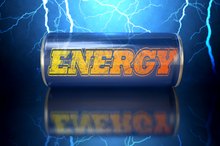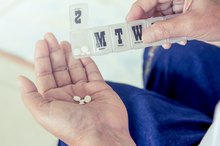Side Effects of N.O.-Xplode
Drink a beverage made with N.O.-Xplode powder 20 to 30 minutes before your workout and you'll have greater energy, endurance and mental focus, says the supplement's manufacturer, Bio-Engineered Supplements and Nutrition, or BSN. The U.S. Food and Drug Administration doesn't regulate the supplement, and all possible side effects may not have been identified, though it does contain some ingredients, such as creatine, that may benefit athletes. Avoid N.O.-Xplode if you are under age 18, take medication, have a medical condition or are pregnant, nursing or trying to get pregnant. Don't take more than recommended, and seek medical help if you experience any severe, persistent symptoms with use.
Effects of Caffeine
Each scoop of N.O.-Xplode contains 200 milligrams of caffeine. If you drink two of the prepared drinks daily, the maximum amount advised by BSN, the caffeine you'd consume is more than the 300 milligrams recommended as moderate intake for healthy adults. This amount would rise if you have any other caffeine-containing products, including coffee, tea, soda, energy drinks, chocolate or some other exercise supplements. Excessive caffeine intake may cause insomnia, irritability, an usually rapid heartbeat, anxiety, vomiting, shaking, nausea and depression.
- Each scoop of N.O.-Xplode contains 200 milligrams of caffeine.
- This amount would rise if you have any other caffeine-containing products, including coffee, tea, soda, energy drinks, chocolate or some other exercise supplements.
Effects of Niacin
How to Take BSN N.O.-Xplode
Learn More
A number of B vitamins, including niacin, are N.O-Xplode ingredients. They help break down fats, proteins and carbohydrates for energy. N.O.-Xplode has 20 milligrams of niacin per scoop. While this is 15 milligrams less than the tolerable upper intake level, or UL, for niacin, two N.O.-Xplode drinks daily along with a diet containing niacin-rich foods such as poultry, fish or fortified breakfast cereal will easily push you over the advised limit. Exceeding niacin's UL may cause itchy skin, rashes and flushing, a condition in which the neck, face, chest and arms turn red and feel hot and tingly. Over time, high niacin intake may also increase your risk of liver damage, elevated blood sugar and ulcers.
- A number of B vitamins, including niacin, are N.O-Xplode ingredients.
Effects of Alanine
The bulk of every N.O.-Xplode drink consists of a Master Performance Blend that contains five different proprietary mixtures. One of these mixtures, Endura Shot, is made up of a beta composite that supplies two forms of the amino acid beta-alanine. The manufacturer doesn't reveal the exact amount of beta-alanine in N.O.-Xplode. Although research supports the idea that supplementing with beta-alanine may enhance athletic performance and endurance, registered dietitian Christin L. Seher cautions in Today's Dietitian that large amounts may cause flushing similar to that caused by excess niacin.
- The bulk of every N.O.-Xplode drink consists of a Master Performance Blend that contains five different proprietary mixtures.
- The manufacturer doesn't reveal the exact amount of beta-alanine in N.O.-Xplode.
Effects of Creatine
The Best Way to Lose Weight With Ephedrine
Learn More
Your body uses the amino acid creatine to make phosphocreatine, a compound stored in muscle tissue. The phosphocreatine is metabolized into adenosine triphosphate, or ATP, the body's main source of energy, when you engage in intense, short-term exercise like weight lifting. Supplementing with creatine may improve athletic performance and your level of endurance in non-weight bearing exercise that involves both low- and high-intensity activity, says the University of Michigan Health System. Every scoop of N.O.-Xplode contains 5.5 grams of a proprietary Myogenic Matrix which includes creatine monohydrate, creatine anhydrous and a creatine peptide combination of whey protein isolate and creatine monohydrate.
- Your body uses the amino acid creatine to make phosphocreatine, a compound stored in muscle tissue.
- The phosphocreatine is metabolized into adenosine triphosphate, or ATP, the body's main source of energy, when you engage in intense, short-term exercise like weight lifting.
Related Articles
References
Writer Bio
Michelle Kerns writes for a variety of print and online publications and specializes in literature and science topics. She has served as a book columnist since 2008 and is a member of the National Book Critics Circle. Kerns studied English literature and neurology at UC Davis.









